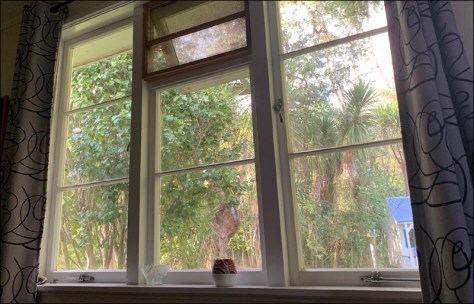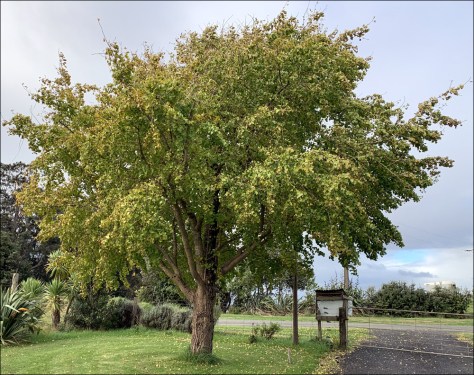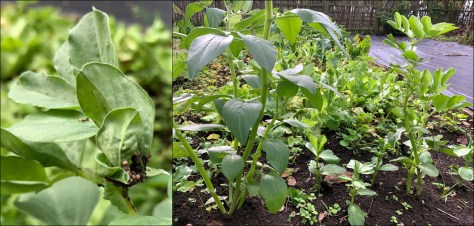Changing of the Seasons

The Weather
It’s been windy over the past week or two, with several drenchings of heavy rain. Each morning I wake up to the sound of the noisy sparrows in the totara outside my window, and try to guess what the weather is like outside. I part the curtains and see the early morning trees dark against the bedroom window, the thin first rays of light filtering through. I get up and start thinking about what I have planned for the day.
Despite the inclement and changeable weather, when the sun does appear, it’s unseasonably warm, often reaching 20 or 21 C. And once the clouds peel back, the washed-out blue of an early winter sky reveals the bright sun, scattering a saffron veil over the fields of maize husks, and polishing the freshly-mowed lawns to a luminous lime green.

Last week’s persistent Nor ‘westerly has gone. Such a wind buffets the house, rattling the windows and clattering seed pods and dried leaves onto the corrugated iron roof. It shakes the Gingko by the front gate, causing it to shed its yellow leaves in a spectacular manner; they rise up into the air on a puff of wind, only to be tossed over the wire fence and onto the gravel road beyond.
It’s definitely been time to get the wood burner cranked up and we’re really appreciating the work done over Summer to cut and stack firewood and kindling. Getting the fire to the best temperature can be a challenge… too hot and we have to start peeling off clothing items. This somewhat defeats the purpose.
June! It’s hard to believe that we’re so far through the year. Sometimes I wish that we had the occasional frost, but everything just keeps on growing up here in the ‘winterless north’.
The Garden
Growth in the ‘vegetable’ garden (or should I say, ‘weed’ birthing unit) has slowed down quite a bit. Of course this is normal with the shorter days and cooler evening temperatures. The recent rain has left the soil too wet to work – thank goodness we are on a hill and it will quickly drain away.
Vegetables
The carrots and slow-bolting coriander sowed towards the end of April, have sprouted. But the same cannot be said for the golden turnips. These members of the Brassica family usually pop up through the soil within a week, but alas, there’s no sign of them. It really perturbs me when this happens to fresh seeds… when not even one germinates. Why would that be? Is there a creature in the soil that really loves turnip seeds and has munched them all up?

The additional broad beans I added to the row alongside the three baby plants have also struck well. This is something I’m really pleased about as there’s nothing nicer than a velvety broad bean puree, blended with a little butter and generously seasoned with freshly-ground black pepper and sea salt. I also love the look of the mature plants with their pretty white flowers with their black ‘eyes’, and the way they attract bumble bees. I noticed clumps of aphids on the tender leaf buds… was happy to wash them off with a stream of water.
Fruit
I’ve been surprised at the size of the feijoas I’ve seen for sale in the supermarkets. They’re so small!! Ours are almost finished, but there are still a handful falling heavily onto the grass each day. And while we do have small ones, our larger ones weigh about 100 grams and most of our fruit weigh over 70 grams. Our two feijoa trees are so deceptive – in March we peered up into the branches and we really thought that this year was going to be a ‘rest’ year. I guess the fruit were hiding amongst the leaves.

It’s always rewarding for someone who didn’t even see an avocado until around age 19, to see them fattening up on the trees outside. I was introduced to this luscious fruit by Tina, the mother of my Chilean friend, Ceci. Tina spread some avocado flesh on a slice of toast for me to try. I really didn’t like that first taste – it seemed too bland, and the texture was unusual. I was living in Wellington at the time, and later moved to Dunedin where I resided for the next 25 years, and you certainly don’t see avocado growing outside that far south!
Our two avocado trees are the reason we started with our bees. We had a couple of years of many flowers and no pollinators. Fortunately (thanks to the bees) don’t have that problem now, and while our trees don’t have as many fruit as last year, this a good thing, as the trees are still young.

The fruit on our citrus trees is also ripening well. Ripe limes have been falling, and the first mandarins are definitely ready – I’ve eaten a few. The juvenile navel orange has a handful of fruit, finally. Can’t wait to taste those!

Some of the fruit trees are taking a well-deserved rest. For example, our fig tree; it looks like a sun-bleached skeleton amongst all the greenery. It’s hard to believe it was so productive last season, with its plump pink-fleshed fruit. Or that this tree was driven over in reverse by Ben on the ride-on mower when it was a mere toddler. It’s so tall now that we’ll be challenged when it comes time to protect the new fruit in Spring/Summer.
Flowers
Because I was away for most of last year, and for part of this year, the flower garden is in a bad state. The annual weeds have formed a dense carpet on the bare soil, and the perennials are well-established, BUT, even so, I’ve found some bright and cheerful offerings amongst the jungle.

Ben’s Bromeliad circle brightens up the entrance as you come through the gate. He’s planted them on the stump of a Redwood that used to grow adjacent to the driveway.

And in the corner of the garden that we are letting revert back to native plants, a hibiscus that I’d forgotten about completely, has produced a couple of flowers. We recently cleared away a lot of dead branches and that most annoying noxious weed, ivy, and the increase in light must have been beneficial for this beautiful flower.

Winter Thoughts
The garden is mostly at rest, but the signs of new life are everywhere. I have the feeling that I’ll have to get a wriggle on and get things organised… so much to do, so little time. For starters, the shortest day is traditionally the time to plant garlic, so I’ll have to get those beds ready. There are perennial flowers that really should be dug up and divided. The roses need pruning. And what about writing, when on earth am I going to get on to that?
Dad’s in care, living out his last few weeks, day by day, hour by hour. My focus on gardening is (I’m sure) the way I’m managing the range of thoughts that go through my mind. Dad has always loved the land and growing things. In fact, one of my early memories is of standing on the end of the rake while Dad earthed up the potatoes in the vegetable garden. I remember sun, and the complex smell of the warm soil, that it was fun and I felt happy.
I wrote this on Sunday as I lay in bed, trying not to think about the huge thing that wants to be thought about…
Chasing Sleep
Tonight I feel sad. Dad’s by himself. Tossing and turning even in his dreams under thin covers on a plastic-sheeted bed. His body leaks fluids and his brow is hot. Alone, and maybe lonely. I wonder if he thinks he’s in a hell of some kind.
Mum’s gone on ahead and us kids are in our own beds tonight.
I’m by myself, too, but this time there’s no chance that Dad will come home after dark having walked from Wallaceville Station, to quietly push my bedroom door open, his silhouette shaped by the hall light, to sit on the edge of my bed and wish me goodnight.
0035, 29 May , 2021









